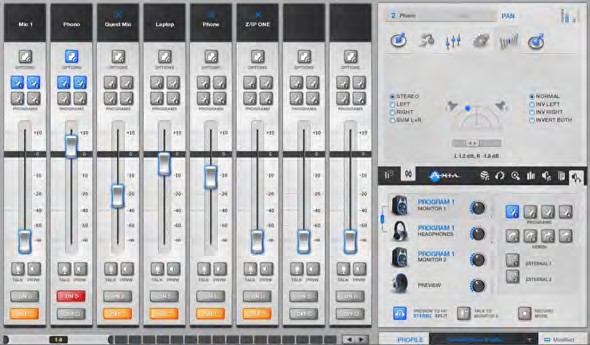SoftSurface Overview {LEGACY PRODUCT}
SoftSurface Virtual Console software for Windows gives you powerful real-time control of your Axia Fusion or Element mixing console from home, office, or anywhere an Internet connection is available. Take direct remote control of your console, or, match SoftSurface directly to an Axia mixing engine to create a “virtual console” without a physical mixing surface. SoftSurface makes an ideal companion for existing consoles and it’s also the perfect audio mixing solution for limited-space locations.
SoftSurface Features {LEGACY PRODUCT}
-
Gives full remote control of Fusion or Element consoles paired with Axia StudioEngine mixing engines.
-
Pair directly with an Axia StudioEngine or PowerStation® to create a standalone “soft” console without a physical mixing surface. Supports from 4 to 48 faders in this mode.
-
NTP-capable on-screen time of day clock/calendar.
-
On-screen count-up event timer.
-
Supports up to four Show Profiles console “snapshots” for instant recall of frequently-used configurations.
-
Control all four program buses and all auxiliary mix buses.
-
Remote control of mic compression, de-essing and expansion capabilities.
-
On-screen control of per-source three-band parametric EQ.
-
Excellent IFB Talkback capabilities let operators talk to other studios, external remote feeds, phone callers or any other source with its own backfeed.
-
Full control of GPIO functions.
-
When paired with Axia consoles equipped with motorized faders, physical fader position automatically mirrors that of the “virtual” SoftSurface fader
SoftSurface In Depth {LEGACY PRODUCT}
Control at the Click of a Mouse.
You asked for a way to remotely control your console. Axia heard you! Meet SoftSurface, the audio mixing application for Windows.
You can use SoftSurface two ways. As a remote control, it gives powerful real-time control of premium Axia mixing consoles, utilizing an Axia StudioEngine or PowerStation that’s connected to a Livewire® network. It’s perfect for remote diagnostics or off-site operation of a mixing console from remotes, transmitter sites — even from home, via an Internet gateway.
As a virtual console, SoftSurface combines with an Axia StudioEngine or PowerStation to create a “soft” mixing surface. It’s perfect for those limited-space situations where there’s no room for a real console. With SoftSurface, if you’ve got a Windows laptop and an IP connection, you’re good to go.
Now, when we say SoftSurface lets you control a console, we don’t mean a wimpy console. You get all the functionality and features of Axia’s extremely popular Element and Fusion modular mixing surfaces, the boards at the heart of thousands of superb broadcast facilities around the world.
SoftSurface opens up new dimensions of creative applications for broadcasters. Remote broadcasts get easier: your talent can take a tablet with SoftSurface, a USB mic and a Telos® Z/IP ONE IP Codec into the field, link up with the Element console at your studio, and have its entire suite of capabilities at their fingertips — leave those CDs and MP3 players at home.
Or, pair SoftSurface with a StudioEngine or PowerStation mixing engine for a “virtual console” installation in personal studios, or areas where space restrictions don’t permit a physical control surface.
The SoftSurface display is divided into a virtual mixing surface and a control section. The mixing section’s onscreen width varies based on the number of channels you wish to display, while the context-sensitive control section is fixed in size, and navigation is via a series of intuitive tabs.

The Main Monitor tab provides control of the monitor speakers, operator headphones, external monitor speakers, and preview volume.

The Show Profiles tab reveals the profiles that have been configured and allows the user to select a show and load it. As few as one or as many as 99 Show Profiles are supported.

Monitor Options provides control over dimming values and control of the channel feeding the monitors and headphone.

The Meter Options tab provides control over the presentation of the meters, including choice of metering ballistics styles: VU, BBC and DIN-style PPM, EBU Digital and Nordic.

Auxiliary Send and Return provides control of the final AUX send mix, as well as two auxiliary returns, as defined in the Show Profile. The returns can be assigned to a program bus. These options are defined in
a Show Profile and controlled as needed by the user. Individual sources can be assigned to feed one or all
AUX Send buses from the Channel Options Aux Send screen.

EQ curves are adjustable for each audio source. EQ can be adjusted on the fly, or saved as part of a source’s Source Profile and automatically recalled whenever that source is loaded to a fader.

Mic, Codec and Phone sources can be sweetened with Voice Dynamics from Omnia®. Expansion, Compression and De-Essing are part of the toolkit; Like EQ, dynamics settings can be adjusted at will or preset and saved with sources for automatic recall.

SoftSurface’s signal processing toolkit is completed with comprehensive Pan, Summing and Phase control, available on a per-source basis.
SoftSurface Specifications {LEGACY PRODUCT}
Hardware Requirements
-
A PC with Microsoft™ Windows XP or higher operating system installed.
-
A display screen with a minimum resolution of 1280x1024 pixels.
-
A mouse, touch-screen, or other suitable pointing device.
-
A 100BASE-T LAN connection with a static IP address.
-
20Mb free disk space.
Audio Processing
Equalizer
-
Frequency Bands: 20Hz to 320Hz, 125Hz to 2KHz, 1.25KHz to 20KHz.
-
Cut/Boost range on each band: -25dB to +15dB.
-
Q-factor: Automatic - bandwidth varies based on amount of cut or boost.
Compressor
-
Threshold: -30dB to 0dB Ratio: 1:1 to 16:1
-
Post-processor Trim Level: Adjustable from -20dB to +20dB
Expander/Noise Gate
- Threshold: -50dB to 0dB Ratio: -30dB to 0dB
De-esser
- Threshold: -20dB to 0dB Ratio: 1:1 to 8:1
Regulatory
-
Click here to view the current regulatory compliance

























